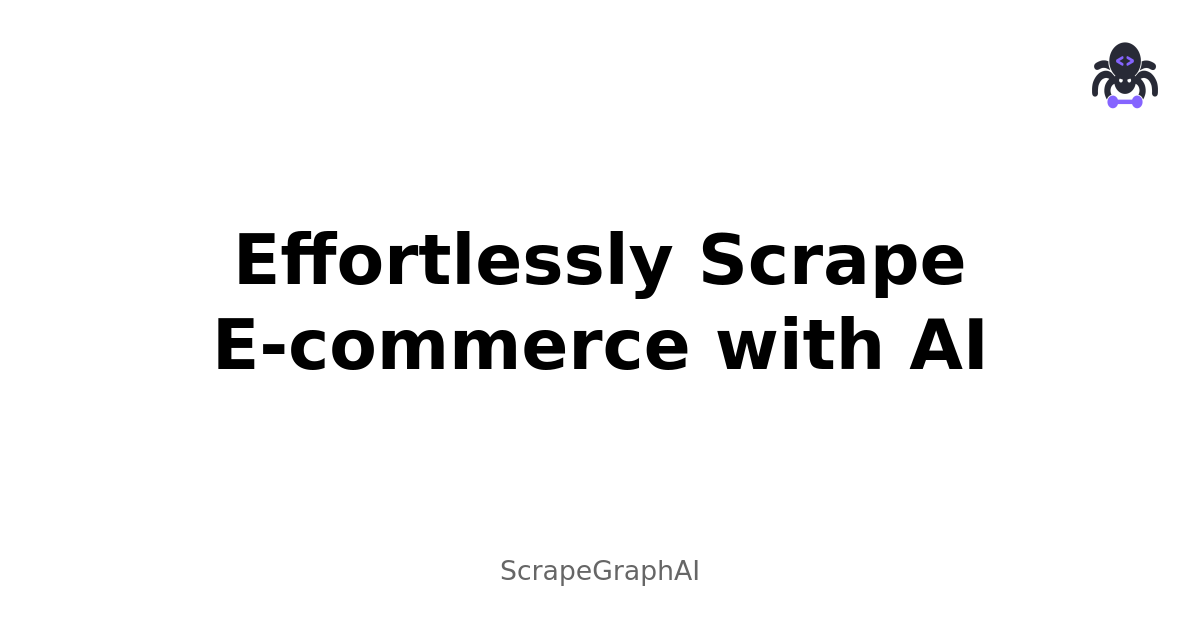How to Scrape E-commerce Websites with AI
Introduction
In the fast-paced world of e-commerce, data is king. Whether it's tracking prices, monitoring competitors, or analyzing market trends, having access to the right data can give businesses a significant competitive edge. However, traditional web scraping methods often fall short when it comes to handling the dynamic and complex nature of e-commerce websites. This is where ScrapeGraphAI steps in, offering a revolutionary AI-powered solution that simplifies data extraction without the need for brittle CSS selectors and complex XPath expressions.
Why ScrapeGraphAI is the Solution
ScrapeGraphAI leverages advanced Large Language Models (LLMs) to understand web page content semantically, allowing you to extract exactly what you need with just a natural language prompt. This not only eliminates the need for maintenance-heavy scrapers but also ensures that your data extraction processes are robust against changes in website structures.
Key Benefits:
- AI-Powered Extraction: Extract data with natural language prompts, no coding expertise required.
- Zero Maintenance: Self-healing technology adapts to website changes automatically.
- No Proxies Needed: Built-in proxy rotation and browser automation.
- Production-Ready: Used by over 1 million users with a 99.9% uptime guarantee.
Step-by-Step Implementation Guide
Let's walk through how you can use ScrapeGraphAI to scrape e-commerce websites effectively.
Step 1: Set Up Your Environment
Start by signing up for ScrapeGraphAI at scrapegraphai.com and get your API key.
Step 2: Choose Your Language and Set Up the SDK
ScrapeGraphAI supports multiple languages, including Python and JavaScript. We'll demonstrate both, along with a cURL example.
Python Code Example
import requests
API_KEY = 'your_api_key_here'
headers = {
'Authorization': f'Bearer {API_KEY}',
'Content-Type': 'application/json'
}
url = 'https://api.scrapegraphai.com/v1/smartscraper'
data = {
'user_prompt': 'Extract the product name, price, description, availability, and customer ratings from the product page.',
'url': 'https://example.com/product-page'
}
response = requests.post(url, headers=headers, json=data)
print(response.json())JavaScript Code Example
const axios = require('axios');
const API_KEY = 'your_api_key_here';
const config = {
headers: {
'Authorization': `Bearer ${API_KEY}`,
'Content-Type': 'application/json'
}
};
axios.post('https://api.scrapegraphai.com/v1/smartscraper', {
user_prompt: 'Extract the product name, price, description, availability, and customer ratings from the product page.',
url: 'https://example.com/product-page'
}, config)
.then(response => {
console.log(response.data);
})
.catch(error => {
console.error(error);
});cURL Code Example
curl -X POST https://api.scrapegraphai.com/v1/smartscraper \
-H "Authorization: Bearer your_api_key_here" \
-H "Content-Type: application/json" \
-d '{
"user_prompt": "Extract the product name, price, description, availability, and customer ratings from the product page.",
"url": "https://example.com/product-page"
}'Advanced Tips and Best Practices
- Use Natural Language Prompts: Describe your data extraction needs in plain English to get precise results.
- Monitor Rate Limits: Ensure your usage stays within the rate limits of your subscription tier.
- Optimize API Calls: Batch requests when possible to save on credits and improve efficiency.
FAQ
Q: Can ScrapeGraphAI handle dynamic content? A: Yes, it supports infinite scrolling and dynamic content extraction.
Q: Do I need to manage proxy servers? A: No, ScrapeGraphAI includes built-in proxy management.
Q: Is there a free tier available for testing? A: Yes, ScrapeGraphAI offers a free tier with limited credits.
Conclusion
ScrapeGraphAI offers a cutting-edge solution to the challenges of e-commerce data extraction. By leveraging AI, it simplifies the process, reduces maintenance, and ensures robust data collection. Sign up today to revolutionize your web scraping capabilities.
Try ScrapeGraphAI now and take your data extraction to the next level!
